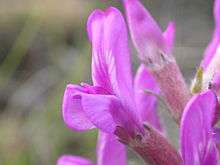Oxytropis lambertii
Oxytropis lambertii is a species of flowering plant in the legume family known by several common names, including purple locoweed, woolly locoweed, and Lambert crazyweed.
| Oxytropis lambertii | |
|---|---|
 | |
| Scientific classification | |
| Kingdom: | |
| (unranked): | |
| (unranked): | |
| (unranked): | |
| Order: | |
| Family: | |
| Subfamily: | |
| Tribe: | |
| Genus: | |
| Species: | O. lambertii |
| Binomial name | |
| Oxytropis lambertii | |
Distribution
It is native to grasslands in the Canadian Prairie of central Canada and in the mid-west and Great Plains of the United States.[1]
Description
Oxytropis lambertii is a perennial herb producing a patch of basal leaves around the root crown, and several showy erect inflorescences. The leaf is compound with several silvery-green leaflets. The inflorescence produces several flowers, each borne in a tubular purple or pinkish calyx of sepals covered thinly in silver hairs. The pealike flower corolla is reddish or bluish purple with a lighter patch at the base of the banner. The fruit is a cylindrical legume pod.
Toxic
The Oxytropis lambertii plant is one of the locoweeds most frequently implicated in livestock poisoning.[2] The toxin is called swainsonine. Research suggests that the plant itself may not be toxic, but becomes toxic when inhabited by endophytic fungi of the genus Embellisia, which produce swainsonine.[3]
See also
References
- USGS. Native Wildflowers of the North Dakota Grasslands
- Ralphs, M. H., et al. (2002). Distribution of locoweed toxin swainsonine in populations of Oxytropis lambertii. J Chem Ecol 28:4 701-7.
- McLain-Romero, J., et al. (2004). The toxicosis of Embellisia fungi from locoweed (Oxytropis lambertii) is similar to locoweed toxicosis in rats. J Anim Sci 82 2169-74.